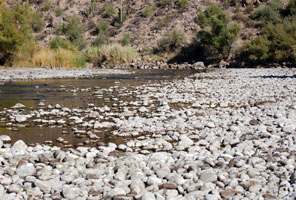Colorado River Drought Forces a Painful Reckoning for States
By Michael Wines via The New York Times on January 5, 2014
The sinuous Colorado River and its slew of man-made reservoirs from the Rockies to southern Arizona are being sapped by 14 years of drought nearly unrivaled in 1,250 years.
 The once broad and blue river has in many places dwindled to a murky brown trickle. Reservoirs have shrunk to less than half their capacities, the canyon walls around them ringed with white mineral deposits where water once lapped. Seeking to stretch their allotments of the river, regional water agencies are recycling sewage effluent, offering rebates to tear up grass lawns and subsidizing less thirsty appliances from dishwashers to shower heads.
The once broad and blue river has in many places dwindled to a murky brown trickle. Reservoirs have shrunk to less than half their capacities, the canyon walls around them ringed with white mineral deposits where water once lapped. Seeking to stretch their allotments of the river, regional water agencies are recycling sewage effluent, offering rebates to tear up grass lawns and subsidizing less thirsty appliances from dishwashers to shower heads.
But many experts believe the current drought is only the harbinger of a new, drier era in which the Colorado’s flow will be substantially and permanently diminished.
Faced with the shortage, federal authorities this year will for the first time decrease the amount of water that flows into Lake Mead, the nation’s largest reservoir, from Lake Powell 180 miles upstream. That will reduce even more the level of Lake Mead, a crucial source of water for cities from Las Vegas to Los Angeles and for millions of acres of farmland.
Reclamation officials say there is a 50-50 chance that by 2015, Lake Mead’s water will be rationed to states downstream. That, too, has never happened before.
“If Lake Mead goes below elevation 1,000” — 1,000 feet above sea level — “we lose any capacity to pump water to serve the municipal needs of seven in 10 people in the state of Nevada,” said John Entsminger, the senior deputy general manager of the Southern Nevada Water Authority.
Since 2008, Mr. Entsminger’s agency has been drilling an $817 million tunnel under Lake Mead — a third attempt to capture more water as two higher tunnels have become threatened by the lake’s falling level. In September, faced with the prospect that one of the tunnels could run dry before the third one was completed, the authority took emergency measures: still another tunnel, this one to stretch the life of the most threatened intake until construction of the third one is finished.
These new realities are forcing a profound reassessment of how the 1,450-mile Colorado, the Southwest’s only major river, can continue to slake the thirst of one of the nation’s fastest-growing regions. Agriculture, from California’s Imperial Valley to Wyoming’s cattle herds, soaks up about three-quarters of its water, and produces 15 percent of the nation’s food. But 40 million people also depend on the river and its tributaries, and their numbers are rising rapidly.
Continue the article and view multimedia at The New York Times.
Arizona water shortage forecast for next year
From Channel 12 News in Phoenix, watch Brahm Resnik’s interview with DCDC Director, Dave White, to get his take on the recent New York Times article by Michael Wines on drought in the West. Check out the video at AZCentral.com.
Read more about drought in the West from DCDC
Garrity, C.M., R.S. Cerveny, and E.A. Wentz. 2010. Vertical moisture profile characteristics of severe surface drought and surface wetness in the western United States: 1973-2002. International Journal of Climatology 30(6):894-900.
Balling, R.C., and G.B. Goodrich. 2010. Increasing drought in the American Southwest? A continental perspective using a spatial analytical evaluation of recent trends. Physical Geography 31(4):293-306.
Ellis, A.W., G.B. Goodrich, and G.M. Garfin. 2010. A hydroclimatic index for examining patterns of drought in the Colorado River Basin. International Journal of Climatology 32(2):236-255. DOI: 10.1002/joc.1882.
How Will the Current Drought Affect Our Future Water Supply? By Sally Wittlinger, DCDC Research Analyst in Arizona Indicators Policy Points.

